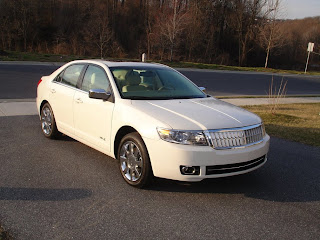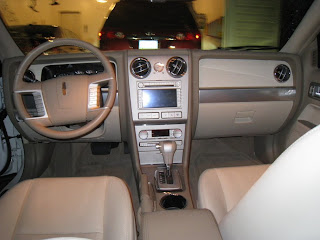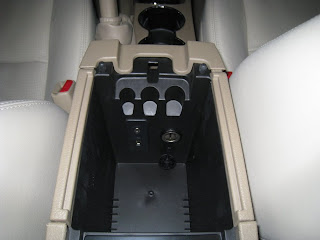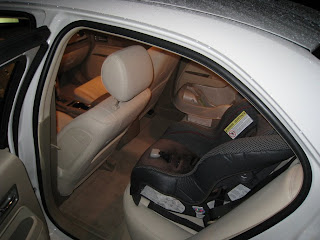2008 Lincoln MKZ AWD Review
Last week, Lincoln provided a loaded pearl white MKZ AWD for me to evaluate. I was eager to check out the MKZ, since it’s a good looking car and seems to have a lot of great features on paper. Not only that, but I was dying to finally get a chance to try Ford’s SYNC system, which of course was developed in partnership with Microsoft.
The MKZ that I drove had every option available, including chrome 17″ wheels, DVD navigation, HID headlamps, the interior satin/aluminum package, THX II Audiophile Sound, heated and cooled seats, and a power moonroof. Overall, the car had about $6,000 in options added to its $33,165 base price.
Exterior
 The MKZ is a handsome car, particularly in the front end. Of course, those in the know are aware that it’s basically an upgraded and rebadged Ford Fusion. The two cars share no visible interior parts, and the MKZ’s exterior is unique except for the area between the A-pillar and C-pillar (the doors and greenhouse). The problem with the MKZ’s shape is, however, that for a car that was introduced in the 2006 model year (as the Lincoln Zephyr, a name which only lasted one model year until the goofy MK_ names began), the styling is starting to look a little dated already. The center section of the car is very bland, with a shape as forgettable as nearly any other midsize sedan, such as a Honda Accord, Toyota Camry, or a Ford Fusion, but with a windshield whose base is pushed forward very far so that it’s less upright than it would be in a traditional sedan. The front clip is not only attractive, but unique-looking. The large chrome grille is its prominent feature, and it has a style that doesn’t look anything like an Asian or European vehicle. In the back, a very large Lincoln crosshair logo is one of the car’s most prominent features, but aside from that, it’s difficult to tell what kind of car it is. The taillights are arranged horizontally, but aren’t very interesting to look at.
The MKZ is a handsome car, particularly in the front end. Of course, those in the know are aware that it’s basically an upgraded and rebadged Ford Fusion. The two cars share no visible interior parts, and the MKZ’s exterior is unique except for the area between the A-pillar and C-pillar (the doors and greenhouse). The problem with the MKZ’s shape is, however, that for a car that was introduced in the 2006 model year (as the Lincoln Zephyr, a name which only lasted one model year until the goofy MK_ names began), the styling is starting to look a little dated already. The center section of the car is very bland, with a shape as forgettable as nearly any other midsize sedan, such as a Honda Accord, Toyota Camry, or a Ford Fusion, but with a windshield whose base is pushed forward very far so that it’s less upright than it would be in a traditional sedan. The front clip is not only attractive, but unique-looking. The large chrome grille is its prominent feature, and it has a style that doesn’t look anything like an Asian or European vehicle. In the back, a very large Lincoln crosshair logo is one of the car’s most prominent features, but aside from that, it’s difficult to tell what kind of car it is. The taillights are arranged horizontally, but aren’t very interesting to look at.
Interior
 Although the MKZ isn’t an unattractive car, its best side is probably the inside. My tester was equipped with a two-tone tan interior that looked downright opulent. The seats were a light hue, nearly a creamy white shade (called “sand”) and the fronts were perforated leather. Neither my wife nor I were crazy about the aluminum-looking plastic covering the entire center stack, including radio and HVAC buttons, but Lincoln has been consistently using it for a few years in most of its models. Finally, the steering wheel was about 25% too large for my liking. I’m not sure if Lincoln shares the MKZ’s steering wheel with the Navigator, but it certainly felt like they did. The dashboard was a little too angular for my liking, but at least the entire thing was covered in a padded material. I actually enjoyed poking around at a soft dashboard, because it’s not a feature one sees very often in the new car market in 2008.
Although the MKZ isn’t an unattractive car, its best side is probably the inside. My tester was equipped with a two-tone tan interior that looked downright opulent. The seats were a light hue, nearly a creamy white shade (called “sand”) and the fronts were perforated leather. Neither my wife nor I were crazy about the aluminum-looking plastic covering the entire center stack, including radio and HVAC buttons, but Lincoln has been consistently using it for a few years in most of its models. Finally, the steering wheel was about 25% too large for my liking. I’m not sure if Lincoln shares the MKZ’s steering wheel with the Navigator, but it certainly felt like they did. The dashboard was a little too angular for my liking, but at least the entire thing was covered in a padded material. I actually enjoyed poking around at a soft dashboard, because it’s not a feature one sees very often in the new car market in 2008.
However, that dashboard whose shape I disliked and whose texture I liked also was far too high for my taste. At 6’4″, it’s unusual for me to feel small when sitting in any vehicle, but I constantly had that feeling in the MKZ. The cowl is too high and the bottoms of the side windows are too high. While it helps the car’s exterior styling to look more modern, it struck me as a “function following form” choice from Ford’s designers. The high cowl reminded me of my grandpa’s old 1983 Chevy Impala’s, and the high window opening made patronizing drive-up windows a difficult feat. More than once, my hand hit the top of the door panel rather than making its way through the window to transact business. I unscientifically compared the dashboard height of the MKZ against my 2004 Accord, and the MKZ’s dashboard was aligned with my chin, while the Accord’s was aligned with my rib cage. That’s a difference of several inches, and made it difficult for me to find a driving position that combined clear sightlines with appropriate legroom, while preventing my hair from scraping the ceiling.
 Other than my gripes above, the interior overall was excellent. The seats were comfortable during several hourlong commutes, the automatic climate control worked flawlessly, and the THX II stereo sounded great. SYNC also worked as advertised. I was able to connect my 5G iPod using its USB cable in about five seconds (the SYNC connections are inside the console as pictured to the left), and also successfully tested the standard 1/8″ line-in jack with my portable XM radio. SYNC had trouble connecting with my LG cell phone, but although I initially blamed the problem on SYNC, the phone was unable to re-connect to our van’s Bluetooth hookup either, and my wife’s Nokia cell phone connected to SYNC in less than a minute. I only had two problems with SYNC. The first was that the voice recognition could get tedious. If I wanted to play a specific U2 song such as “Vertigo” from my iPod, I’d have to push the voice button on the steering wheel, wait for a chime, say, “Audio System,” wait for another chime, say “User Device”, wait for another chime, then say, “Play song “Vertigo.”” It’s a shame that the system makes you navigate to the “User Device” each time you want to do something with it; I would have preferred that it just assume I wanted that selection after choosing it once. The other problem I had with SYNC is that after turning off the car, it always forgot what I had asked it to do previously. So, if I had asked it to “Play artist Coldplay,” it would do that perfectly, and show which track it was playing out of 30-some Coldplay tracks in my library. However, once I got back into the car after work, it would resume the previous Coldplay song but would not move onto the next or previous selections. Hitting the “next track” button on the radio or on the steering wheel would just begin that track again. If the system can remember what song it had been playing, I wish it had been able to remember the rest of my earlier request when turning off the car. Otherwise, SYNC worked exactly as advertised and did a great job of voice recognition. Not only that, but it repeated trickier names like album titles without sounding too robotic or phony.
Other than my gripes above, the interior overall was excellent. The seats were comfortable during several hourlong commutes, the automatic climate control worked flawlessly, and the THX II stereo sounded great. SYNC also worked as advertised. I was able to connect my 5G iPod using its USB cable in about five seconds (the SYNC connections are inside the console as pictured to the left), and also successfully tested the standard 1/8″ line-in jack with my portable XM radio. SYNC had trouble connecting with my LG cell phone, but although I initially blamed the problem on SYNC, the phone was unable to re-connect to our van’s Bluetooth hookup either, and my wife’s Nokia cell phone connected to SYNC in less than a minute. I only had two problems with SYNC. The first was that the voice recognition could get tedious. If I wanted to play a specific U2 song such as “Vertigo” from my iPod, I’d have to push the voice button on the steering wheel, wait for a chime, say, “Audio System,” wait for another chime, say “User Device”, wait for another chime, then say, “Play song “Vertigo.”” It’s a shame that the system makes you navigate to the “User Device” each time you want to do something with it; I would have preferred that it just assume I wanted that selection after choosing it once. The other problem I had with SYNC is that after turning off the car, it always forgot what I had asked it to do previously. So, if I had asked it to “Play artist Coldplay,” it would do that perfectly, and show which track it was playing out of 30-some Coldplay tracks in my library. However, once I got back into the car after work, it would resume the previous Coldplay song but would not move onto the next or previous selections. Hitting the “next track” button on the radio or on the steering wheel would just begin that track again. If the system can remember what song it had been playing, I wish it had been able to remember the rest of my earlier request when turning off the car. Otherwise, SYNC worked exactly as advertised and did a great job of voice recognition. Not only that, but it repeated trickier names like album titles without sounding too robotic or phony.
The trunk in the MKZ was cavernous. Although I didn’t have the opportunity to use it, the combination of a long load floor and a high decklid made a nicely-shaped trunk with plenty of space for nearly anything an owner would reasonably expect to need to carry in it. The trunklid also had gas struts rather than gooseneck hinges, so the cargo area was not compromised by large hinges that tend to crush the contents of some cars’ trunks.
 We have both an infant carrier and convertible car seat in use in our family. Although both fit into the MKZ, it was impossible for me to find a comfortable seating position in front of the infant carrier that did not put the front seatback tight against the infant carrier. Generally, it is advisable to have a few inches of clearance between the two, but this was not possible in the Lincoln (although, ironically it is in my Accord). This issue was what forced us to trade in our SUV for a minivan last December; remember, my wife and I are both very tall, so more normally-sized drivers and front seat passengers may not encounter this problem at all. Note that the photo to the right of this paragraph shows the infant carrier base without the carrier itself in the vehicle.
We have both an infant carrier and convertible car seat in use in our family. Although both fit into the MKZ, it was impossible for me to find a comfortable seating position in front of the infant carrier that did not put the front seatback tight against the infant carrier. Generally, it is advisable to have a few inches of clearance between the two, but this was not possible in the Lincoln (although, ironically it is in my Accord). This issue was what forced us to trade in our SUV for a minivan last December; remember, my wife and I are both very tall, so more normally-sized drivers and front seat passengers may not encounter this problem at all. Note that the photo to the right of this paragraph shows the infant carrier base without the carrier itself in the vehicle.
Driving Experience
The MKZ’s 263-horsepower 3.5 liter V6 and six-speed automatic transmission proved to be a well-matched pair. I never felt wanting for power and never felt like I was in the wrong gear. Even on wet roads, flooring the accelerator from a stop did not cause any wheelspin. Part of that is due, of course, to the car’s all wheel drive, but part is because of the engine’s aggressive torque management program. Several manufacturers do this to help with drivetrain durability, but basically, engine power is limited in first gear at low speeds to avoid sending shocks through the AWD hardware and the transmission. In my opinion, Lincoln should either beef up their components or otherwise figure out a way to eliminate TM, because it felt like it was severely hampering the car’s off-the-line performance. Once TM stopped intervening, the engine noticeably perked up, and the combination of six transmission ratios and 263 horsepower led to quick swings of the tachometer needle within each of the lower gears when accelerating rapidly. Other than torque management, my only drivetrain gripe is the lack of any sort of manual shift option. In terms of forward gears, the choices are only “D” and “L” (also, there is a switch to turn off overdrive). It’s a shame to have six ratios but no way to select most of them manually.
The suspension tuning on the MKZ was a little too floaty for my liking, but at least it doesn’t feel like the last Lincoln I spent a lot of time driving – a Town Car – which gave the sensation of driving a body on frame SUV that happened to look like a sedan. Although it wallowed a bit over uneven road surfaces, it still handled decently, and the 17″ wheels and tires helped keep the car planted on the road.
Fuel Economy
The 2008 MKZ AWD is rated at 17 miles per gallon in the city and 24 miles per gallon on the highway. The all wheel drive hardware adds weight and takes away one mile per gallon city and FOUR miles per gallon on the highway cycle compared to the front wheel drive version (which is rated at 18/28), but of course adds foul-weather security for buyers. In my week with the car over about 300 miles of mixed city, expressway, and back road driving, I got 17.8 miles per gallon – pretty close to the city rating. Still, I was disappointed that the far larger Buick Enclave AWD crossover is rated at 16/22, or only about 1 mpg worse than the MKZ. Competitive vehicles such as the Cadillac CTS AWD and Chrysler Sebring AWD actually have similar fuel economy ratings, however. The lesson here is that buyers will pay a fuel economy penalty for the security of all wheel drive long after the payment book is gone.
Pricing
Pricing of the MKZ starts at $31,720 (including destination) for a front-wheel drive model. The AWD model adds another $1,870, bringing the price to $33,590. Options pushed the price of my test vehicle to $39,265 according to Lincoln.com (the window sticker for the car was prepared before prices increased slightly, and shows a final tally of $38,840). Incentives may bring actual transaction prices to a point several thousand below MSRP. The MKZ offers a lot of car and a lot of features, but I’m not sure that I’d personally be willing to pay $39,000 for the car that I spent a week with.
Bottom Line
While I enjoyed my week with the MKZ, I am convinced that Ford has the capability to do better, and in fact, the upcoming MKS (which is a larger, more expensive car that will serve as Lincoln’s flagship) probably is that car. The driving position and fuel economy were definite negatives, but the feature content and comfort level were the best parts of the car. I appreciated all of the technology that Lincoln packed into the MKZ – navigation, SYNC, all wheel drive, etc. – but found myself wanting for more usable interior space if it was going to use so much fuel.
My parents visited last weekend from out of town, and they were completely enamored with the MKZ. I’ve had a few nice cars in my driveway for testing over the past few months, but this was the first one they showed any kind of interest in. By the way, they’re in their late 50s and early 60s – I’m not sure if they’re the demographic that Lincoln is targeting with this car, but it clearly did hit them somewhere they liked.




